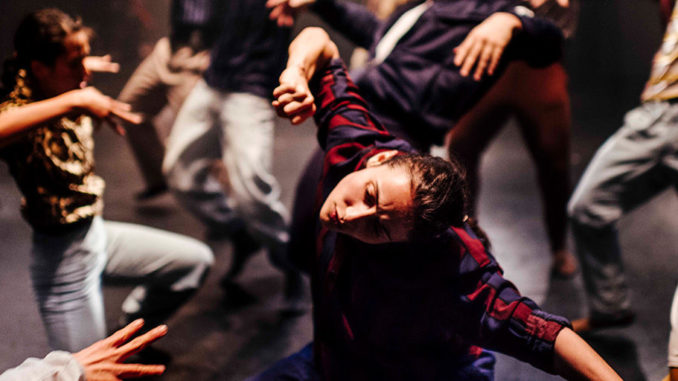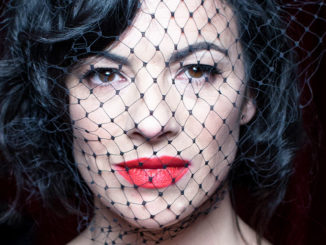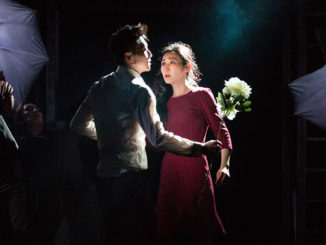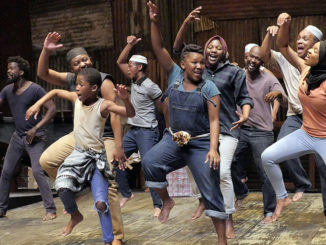
[Another Closing, Another Opening]
The Auckland Arts Festival has a lean offering of dance this year, so it’s fair to say that bringing the London-based Hofesh Shechter Company to the festival is a significant event on the industry’s 2019 calendar. The programming of this work, Grand Finale, feels rich with significance as Aotearoa pulses with the fallout of the Christchurch terrorist attack just a week ago. Auckland Arts Festival Artistic Director Jonathan Bielski introduced the performance and acknowledged the choice of the company to perform, reading a thoughtful and empathic message from Hofesh Shechter to the New Zealand audience.
Grand Finale is deliberately juxtaposed with its title; dark, tumultuous, apocalyptic. Powered by Shechter’s observations of human reactions to living in troubled times, the work reflects the panic/excitement dynamic sparked when things get out of control. The choreographer explains “…Everything collapses but it’s almost like a celebration. It’s a chaotic state of being…and yet there is something amusing about it…” Shechter’s dark sense of humour permeates the work, and although I am aware of it, it doesn’t resonate with me yet.
With Grand Finale Shechter achieves seamless integration of sound, set, lighting and movement. The concept for the set originated from the choreographer’s dream of a city made from Japanese paper, and although it was just a starting point the imagery of solids in flux remains. Designed by Tom Scutt, blank structures move and float, constantly redefining and rearranging the space. Tom Visser’s unparalleled lighting design, in a palette of cool and warm monochrome, is both masterful and remarkable. While these production technologies adapt and respond to the score, it is their interplay that crafts the illusions of Grand Finale. Throughout, the lighting is low and haze is significant, creating dichotomies of seen/unseen/, solid/intangible, definite/indefinite.
Grand Finale exemplifies Shechter’s aptitude and confidence with the stage space. Each element is placed with skill and surety, manipulated with ease, and essential to the choreographic intention. The use of sound is another example; a post-classical score embracing Franz Lehar, Pytor Tchaikovsky, Vladimir Zaldwich, bombastic percussion, and pumping electronic walls of sound. Simultaneously a five piece band interact with the dancers, the audience and the set, playing Titanic-style with stoicism and joie de vevre as the whole sorry mess falls down. The choreography and technical treatment of the band in Grand Finale is unmatched in sophistication and execution.
Which leaves the movement; Shecter’s forte. Inculcated with various ethnic movement vocabularies, the language of this work seeks respectful inspiration not cultural appropriation. Upon arrival in New Zealand, Grand Finale’s kapa haka-inspired section was workshopped with haka practitioner Ngarino Te Waati. Punjabi Bhangra has the strongest presence, and through adept stylisation and repetition emerges as dance/trance motif, ritualistic and frenzied. This approach to global movement is reflected in the company itself – the diverse ensemble of ten dancers come from eight different countries.
Shecter’s choreography of formation and placement is as intelligent and effective as the movement itself. Throughout, the dancers perform with soft, loose wrists and relaxed hands. Costumed in generally coordinated but everyday clothing, the effect is of a universality of reaction and rite. Grand Finale is full of layered unison, with finely balanced stillness, innovation and familiarity. Performed in two acts, the work’s choreography carries its own sense of momentum which seeks to draw the audience in rather than projecting expression out. Eye-contact, therefore, is sparing but effective, as are more common devices such as cannon and levels. Two striking movement sections are an extended phrase performed with the dancers’ mouths wide open, and the poignant waltz partnering completely passive dancers as dead bodies.
In place and time Grand Finale is hauntingly apt, from its conception to its premiere on New Zealand shores. The works blurs the vintage with the futuristic, leaving a space that is undefinable yet unmistakeably human. Everything solid is moving. Everything permanent is temporary. Everything gained will be lost. Or, as Shechter explains “…Perhaps from an optimistic point of view, it’s part of the cycle of life and evolution. Things collapse, and then we build them up again.”
Grand Finale plays the ASB Theatre, Aotea Centre until 23 March.




Leave a Reply